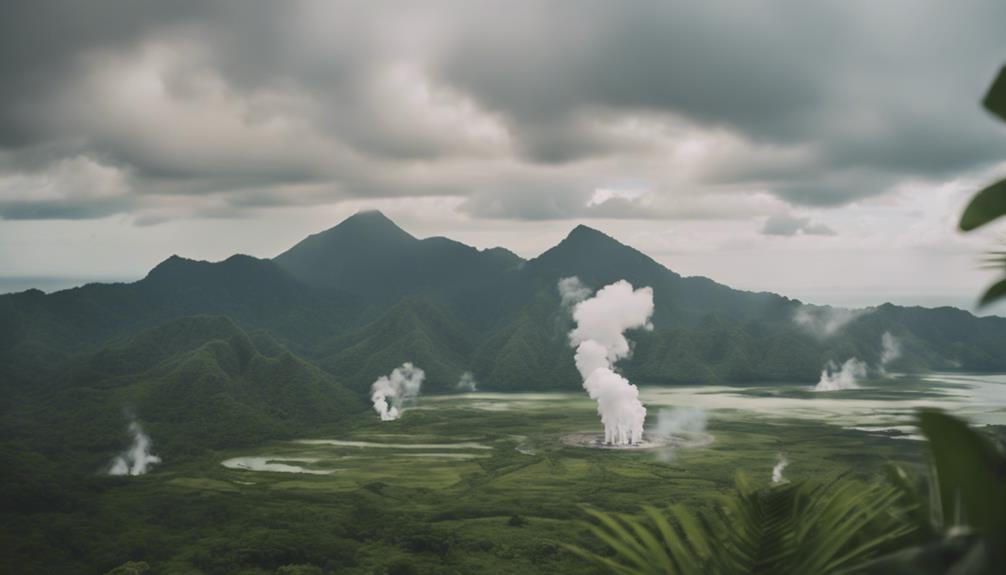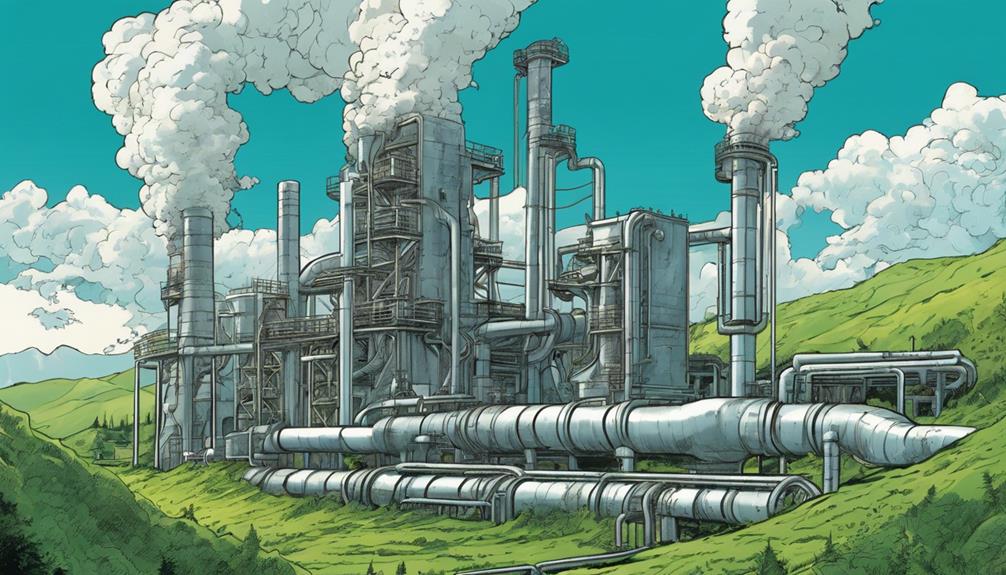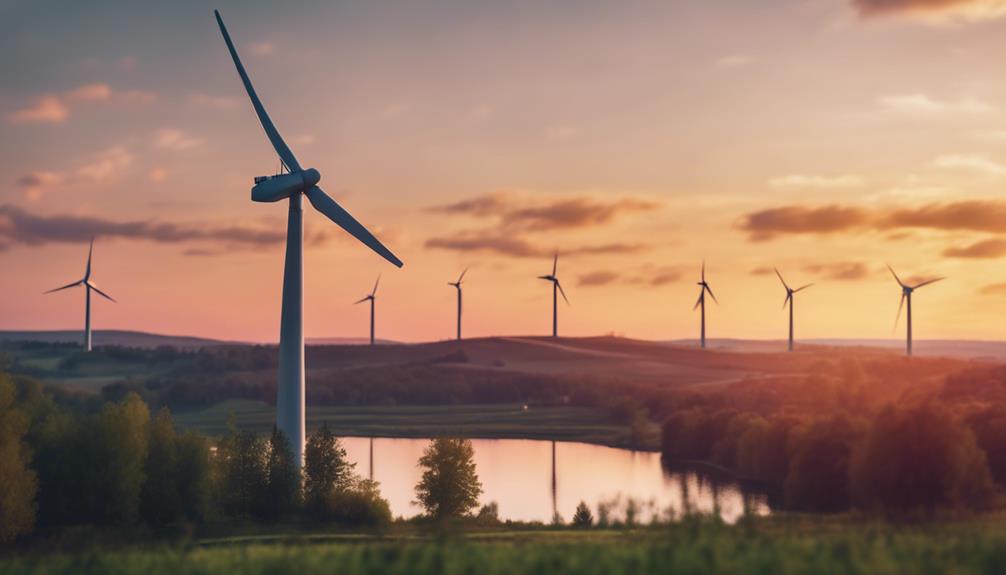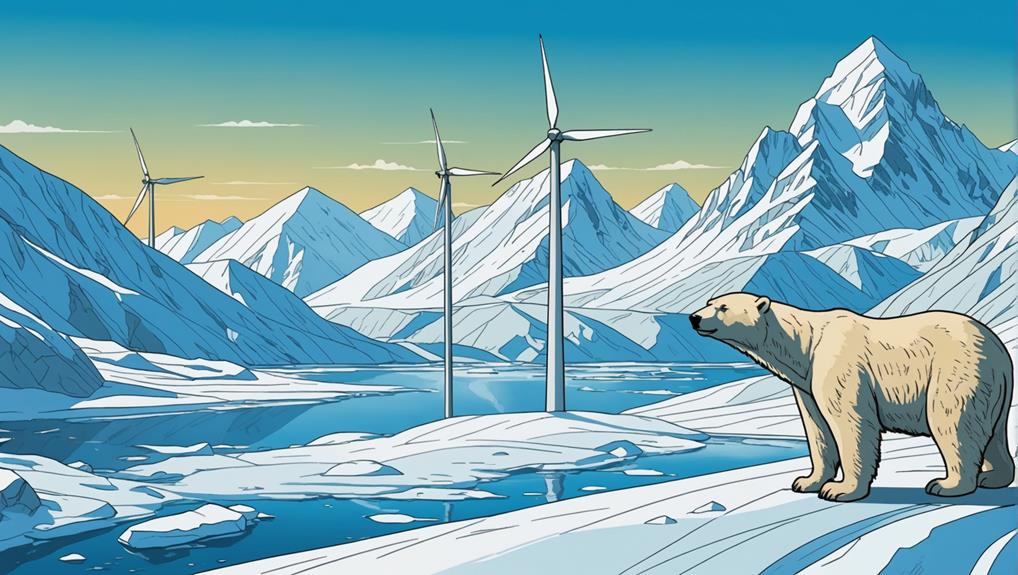The Philippines is rich in geothermal energy due to its location on the Ring of Fire, providing a natural heat source from volcanic activity. Its high geothermal gradient and numerous geothermal fields are shaped by volcanic eruptions and tectonic movements. The country has a strategic goal to double its geothermal capacity by 2040 through research, development, and collaboration efforts. By prioritizing sustainable power generation and reducing greenhouse gas emissions, the Philippines aims to become a regional leader in renewable energy. The unique geological features and government commitment contribute to the Philippines' rich geothermal energy potential.
Key Takeaways
- Location along Ring of Fire zone with volcanic activity.
- High geothermal gradient from volcanic resources.
- Numerous geothermal fields present in the country.
- Geological features shaped by volcanic eruptions.
- Abundance of natural heat sources from volcanic activity.
Abundance of Volcanic Resources
With an abundance of volcanic resources, the Philippines is a prime location for harnessing geothermal energy. Situated along the Ring of Fire zone of Pacific volcanoes, the country benefits from its volcanic resources that provide a natural source of heat for geothermal power generation.
The high geothermal gradient associated with volcanic activity in the Philippines contributes to the abundance of geothermal energy available for utilization. This abundance is further supported by the presence of numerous geothermal fields across the country, a direct result of its unique volcanic and tectonic characteristics.
The geological features created by volcanic eruptions and tectonic plate movements have played a significant role in shaping the Philippines' geothermal energy potential. These features haven't only made the country rich in geothermal resources but also positioned it as a key player in the global geothermal energy sector.
The Philippines' strategic location and geological makeup make it a hotspot for geothermal energy development, highlighting the importance of its volcanic resources in driving sustainable energy initiatives.
Strategic Geothermal Capacity Expansion
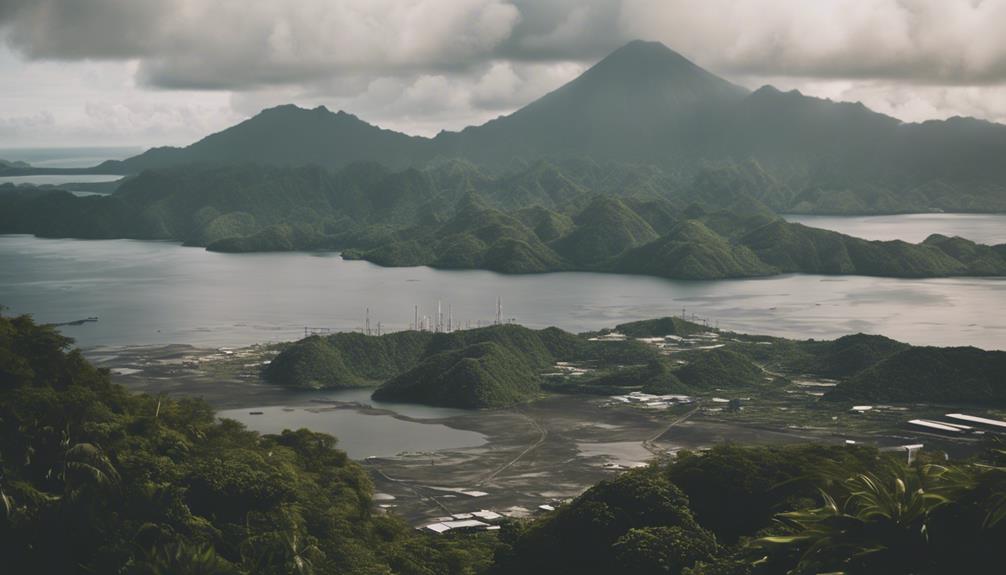
The Philippines' ambitious geothermal capacity expansion plan aims to nearly double its current geothermal capacity by 2040. This strategic move is critical for enhancing the country's energy mix and ensuring energy security through the utilization of renewable sources like geothermal energy.
To achieve this goal effectively, the government is focusing on key areas:
- Research and Development: The Philippines is actively promoting research and development efforts to enhance geothermal technology, making it more efficient and cost-effective in the long run.
- International Partnerships: Collaboration with international partners is vital for the successful implementation of geothermal energy projects in the Philippines. These partnerships bring in expertise, technology, and financial support to drive the expansion plan forward.
- Energy Security: Increasing geothermal capacity plays a crucial role in strengthening the country's energy security by diversifying its energy sources and reducing dependence on fossil fuels.
Energy Security and Sustainability

You should consider the significance of energy independence when discussing geothermal energy in the Philippines. It plays a vital role in reducing reliance on imported fossil fuels, enhancing the country's energy security.
Additionally, the sustainable nature of geothermal power generation aligns well with long-term environmental and energy sustainability goals.
Energy Independence Importance
Enhancing energy independence through the utilization of geothermal resources is essential for the Philippines' energy security and sustainability. Here's why it matters:
- Reduced Dependence on Fossil Fuels: By tapping into geothermal energy, the Philippines can decrease its reliance on imported fossil fuels, mitigating the risks associated with fluctuating global oil prices and geopolitical tensions.
- Promoting Sustainable Power: Embracing geothermal resources enables the Philippines to shift towards a more sustainable energy mix, reducing greenhouse gas emissions and supporting the shift to cleaner energy sources.
- Strengthened Energy Security: Diversifying the energy sources with geothermal power strengthens the country's energy security by decreasing vulnerability to external supply disruptions, ensuring a more stable and reliable energy supply for the nation's development and growth.
Sustainable Power Generation
Geothermal energy plays a pivotal role in ensuring the Philippines' energy security and sustainability. The country's abundant geothermal resources, stemming from its location along the Ring of Fire zone, are essential for power generation and reducing dependency on fossil fuels.
By harnessing geothermal power, the Philippines not only enhances its energy security but also promotes a sustainable energy source that helps in lowering greenhouse gas emissions. Geothermal power generation is instrumental in ensuring a reliable and consistent power supply while contributing to environmental sustainability.
The Philippines' commitment to doubling its geothermal capacity by 2040 underscores the significance of geothermal energy development in meeting the nation's energy needs sustainably. Embracing geothermal energy as a cornerstone of the power generation mix not only secures the country's energy future but also aligns with global efforts towards a greener and more sustainable energy landscape.
National Commitment to Renewable Energy
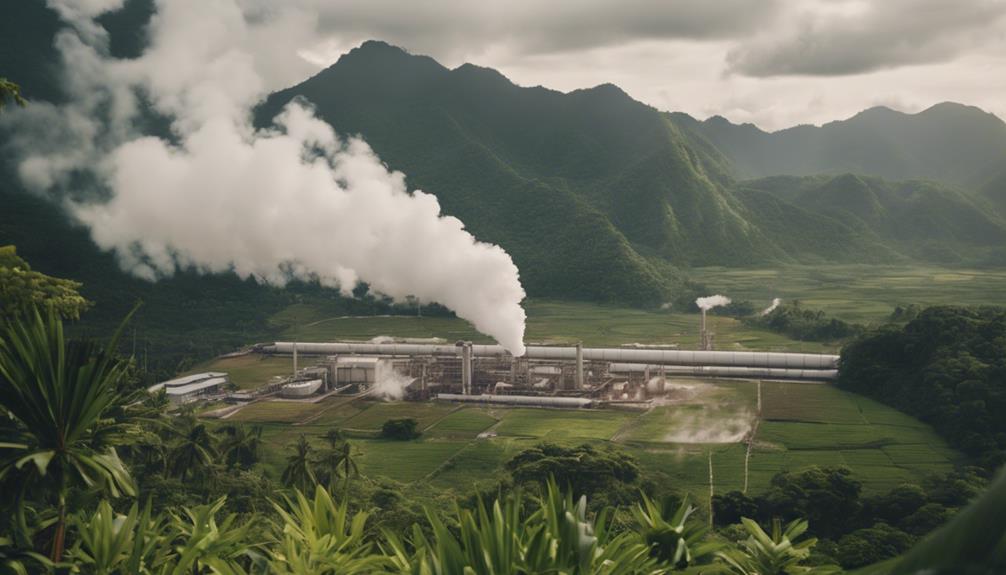
The Philippines has made a significant national commitment to renewable energy, with the goal of reducing carbon emissions by 70% by 2030. This commitment is evident through various initiatives aimed at promoting sustainability and shifting towards cleaner energy sources.
Here are three key aspects highlighting the national commitment to renewable energy:
- Renewable Energy Program: The government has established a robust renewable energy program to increase the share of clean energy sources in the country's energy mix. This program emphasizes the importance of geothermal development in achieving energy security and reducing carbon footprints.
- Government Incentives: Incentives are being provided to encourage investments in geothermal projects. These incentives play a vital role in expanding the renewable energy capacity of the Philippines and fostering a sustainable energy sector.
- Research and Development: Ongoing research and development efforts are focused on advancing geothermal technology. By enhancing technology in this sector, the Philippines aims to further solidify its position as a leader in renewable energy within the region.
Geothermal Industry Challenges
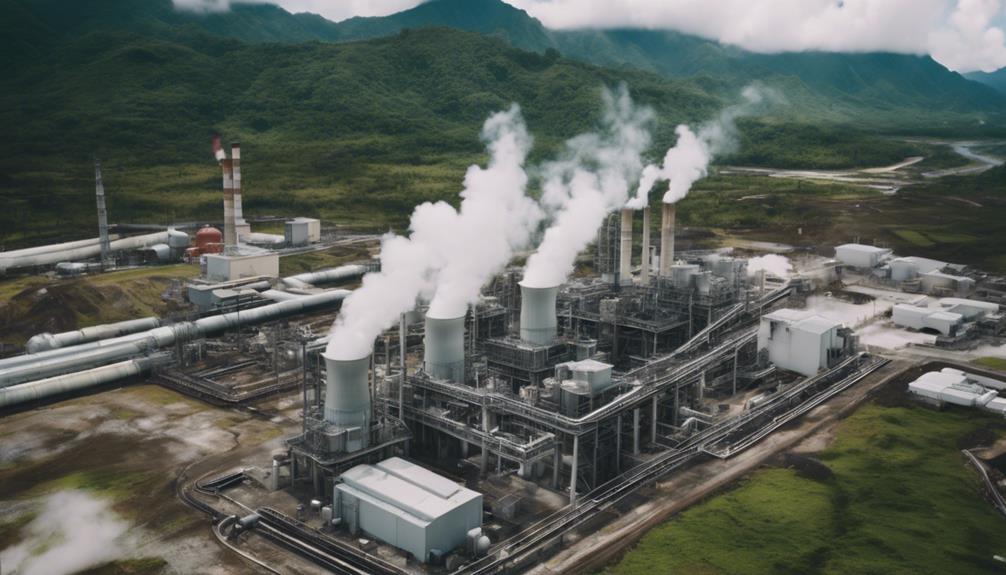
You need to understand the hurdles faced in developing geothermal power plants, assess the economic viability of such projects, and conduct thorough environmental impact studies.
These critical points will shed light on the challenges the geothermal industry in the Philippines encounters and help in devising effective strategies to overcome them.
Development Hurdles Analysis
Moving through the complexities of developing geothermal energy in the Philippines presents significant challenges for industry stakeholders.
When analyzing the hurdles faced in the development of geothermal energy in the Philippines, several key obstacles come to light:
- High Capital Costs: The need for substantial initial investment in building geothermal power plants acts as a barrier to entry for many potential developers, impacting the pace of industry growth in the Philippines.
- Complex Exploration Processes: The intricate exploration and drilling procedures required to tap into geothermal reservoirs add layers of difficulty to project development, further complicating the path to establishing new geothermal facilities in the country.
- Regulatory Obstacles: The presence of regulatory hurdles can impede the progress of geothermal energy projects, requiring developers to navigate through a maze of compliance measures that might delay or deter investments in the sector.
These challenges, including geological conditions, maintenance, and regulatory frameworks, collectively contribute to the intricate landscape of geothermal energy development in the Philippines.
Economic Viability Assessment
Considering the economic viability of geothermal energy in the Philippines poses significant challenges for industry stakeholders. Geothermal exploration in the country comes with high drilling costs, reaching up to US$6 million per well, presenting a substantial financial challenge.
The industry faces hurdles due to the high upfront costs and risks associated with exploration. This situation has led to a stagnation in the development of geothermal energy, with projections indicating a decrease in its share of total power generation.
To address these issues and reignite interest in geothermal power, the government is contemplating allowing foreign ownership of geothermal projects within the country. By evaluating the economic viability of geothermal energy and finding ways to mitigate the financial obstacles, the industry can potentially overcome these challenges and pave the way for sustainable development.
Environmental Impact Study
The challenges faced by the geothermal industry in the Philippines extend to addressing the environmental impacts through thorough studies and risk mitigation strategies.
To tackle these challenges effectively, consider the following:
- Conducting in-depth environmental impact studies is essential for ensuring sustainable development within the geothermal industry. By understanding the potential environmental impacts, you can implement measures to minimize harm to the ecosystem and local communities.
- Prioritizing environmental stewardship in geothermal projects is key to responsible energy production. By integrating environmental considerations into project planning and execution, you can uphold ethical practices and contribute to a healthier environment.
- Maneuvering regulatory challenges while promoting sustainable development requires a proactive approach. Stay informed about environmental regulations and work closely with regulatory bodies to guarantee compliance while fostering the growth of the geothermal industry in a responsible manner.
Philippines' Renewable Energy Transition
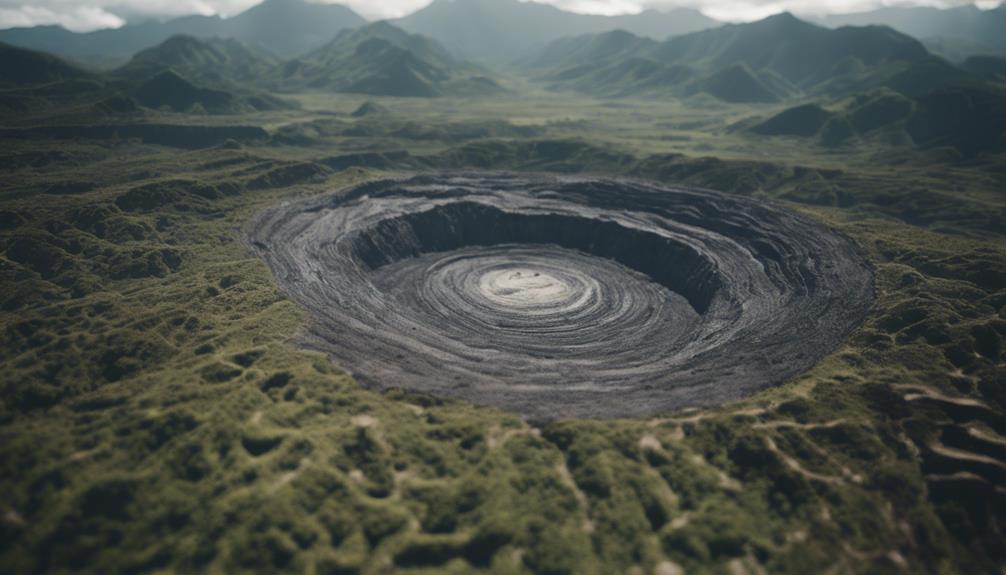
As the Philippines moves towards renewable energy, geothermal power emerges as a vital component in the nation's sustainable energy strategy.
With its abundant geothermal resources, the Philippines is leveraging this clean and sustainable energy source to reduce its dependence on fossil fuels and achieve its energy goals.
The country aims to nearly double its geothermal capacity by 2040, highlighting a significant commitment to shifting towards cleaner energy sources.
Geothermal power plays an essential role in diversifying the energy mix and providing stable, reliable, and environmentally friendly electricity.
Geothermal Development Targets
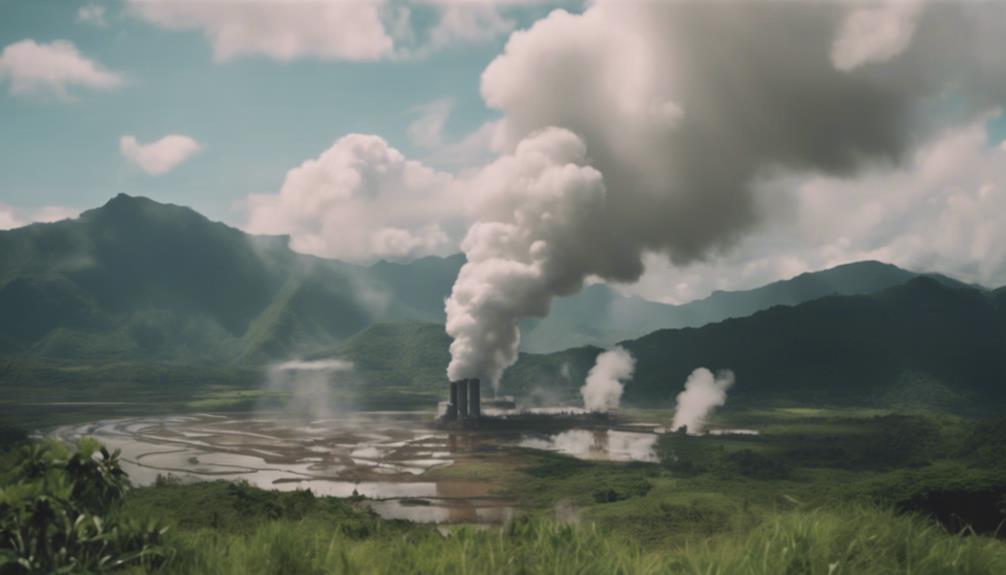
To meet its renewable energy ambitions, the Philippines has established ambitious geothermal development targets to expand its capacity in the coming years. The country's focus on geothermal energy stems from its rich geothermal potential and the need to meet increasing power demand sustainably.
The Philippines has set specific targets to achieve this:
- Short-term goals involve adding 183 MW of geothermal capacity from 2016 to 2020, aiming to kickstart the expansion of geothermal generation.
- Medium-term objectives include adding 900 MW of geothermal capacity from 2021 to 2025, demonstrating a significant increase in geothermal resources.
- Long-term targets aim to further enhance capacity by adding 288 MW from 2026 to 2030, contributing notably to the overall geothermal capacity growth plan.
These targets align with the country's vision of reaching a total installed geothermal capacity of around 3,200 MW by 2030, solidifying its position as a leader in utilizing geothermal energy resources.
Frequently Asked Questions
Why Is the Philippines Rich in Geothermal Energy Because It Is?
Because of its location along the Ring of Fire zone of Pacific volcanoes, the Philippines is rich in geothermal energy. The country's geological setting creates ideal conditions for high-temperature geothermal systems, making it a top producer globally.
Why Would the Philippines Invest More in Geothermal Energy?
You'd invest more in geothermal energy for energy security, reliability, and sustainability. Doubling capacity by 2040 shows commitment to clean power. Geothermal's 24/7 stability and environmental benefits align with renewable energy goals and climate commitments.
Why Is the Philippines Rich in Energy Resources?
You're rich in energy resources due to being located along the Ring of Fire, with high volcanic activity creating ideal conditions. Tectonic plate movements and volcanic features contribute to abundant geothermal reservoirs, aligning with your focus on sustainable energy.
How Does the Philippines Rank in the Production and Use of Geothermal Energy?
You rank third globally in geothermal electricity production, showcasing your significant role in renewable energy. Despite no recent expansions, the goal to boost geothermal capacity highlights your commitment to sustainable energy development.
How Does Geothermal Energy Compare to Hydroelectric Power in the Philippines?
When comparing hydroelectric power vs geothermal energy differences in the Philippines, we can see that geothermal energy has become a more significant source of power in recent years. While hydroelectric power relies on water flow, geothermal energy harnesses the Earth’s heat, providing a more stable and reliable energy source in this region.
Conclusion
To sum up, the Philippines is abundant in geothermal energy thanks to its plentiful volcanic resources and strategic capacity expansion.
With a national dedication to renewable energy and a focus on energy security and sustainability, the country is leading the path towards a more eco-friendly future.
While the geothermal industry encounters obstacles, the Philippines stays resolute in its shift towards renewable energy, establishing ambitious development goals to utilize the potential of its natural resources.
Embrace the potent energy of geothermal in the lush paradise of the Philippines.
